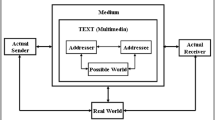Abstract
A need exists within multimedia for a method which evaluates a holistic design as opposed to aspects of a design such as structure or interface style.
Access this chapter
Tax calculation will be finalised at checkout
Purchases are for personal use only
Preview
Unable to display preview. Download preview PDF.
Similar content being viewed by others
References
Aristotle. Poetics Translation by Else, Gerald F. The University of Michigan Press, 1969.
Applebee, Arthur N. The Child’s Concept op Story, University of Chicago Press, 1978.
Barthes, Roland. Introduction to the Structural Analysis of Narratives, 1975.
Bordwell, David. Narrative in the Fiction Film, Routledge, 1985.
Brannigan, Edward. Narrative Comprehension and Film, Edward Brannigan, Routledge, 1992.
Brannigan, Edward. Virginia Broods Film, Perception and Cognitive Psychology Millennium Film Journal No 14/15 Fall/Winter 84–85.
Chatman, Seymour. Story and Discourse: Narrative Structure in Fiction and Film, Cornell University Press, 1978.
Cinema and Television 673, Interactive Narrative Theory, South California, 1995.
Heidegger, Martin. Cited within Understanding Computer’s and Cognition, Winograd and Flores, Wesley, 1986, 1987.
Kozloff, Sahra. “Narrative Theory and Television” within Channels of Discourse Reassembled, Routledge, 1992.
Laurel, Brenda. Computers as Theatre, Addison-Wesley, 1993.
Masterman, Len. Teaching the Media, Routledge, 1985.
MENO project. ESRC Cognitive Engineering Programme, Institute of Educational Technology, Open University, 1995. [focuses on understanding the form and function of narrative in educational and interactive multimedia programmes]
Ricoeur, Paul. Time and Narrative, translated by Kathleen McLaughlin and David Pellauer, University of Chicago Press, 1985.
Stratford, Michael. Investigation Into the Design of Educational Multimedia: Video, Interactivity and Narrative, PhD thesis, Open University, 1994.
Vygotsky, L.S. Thought and Language, M.I.T. Press, 1962.
Vygotsky, L.S. The Psychology of Art, M.I.T. Press, 1971.
Winograd and Flores. Understanding Computer’s and Cognition, Wesley, 1987.
Author information
Authors and Affiliations
Editor information
Editors and Affiliations
Rights and permissions
Copyright information
© 1997 Springer-Verlag/Wien
About this paper
Cite this paper
Mallon, B., Webb, B. (1997). Evaluating Narrative in Multimedia. In: Harrison, M.D., Torres, J.C. (eds) Design, Specification and Verification of Interactive Systems ’97. Eurographics. Springer, Vienna. https://doi.org/10.1007/978-3-7091-6878-3_6
Download citation
DOI: https://doi.org/10.1007/978-3-7091-6878-3_6
Publisher Name: Springer, Vienna
Print ISBN: 978-3-211-83055-0
Online ISBN: 978-3-7091-6878-3
eBook Packages: Springer Book Archive




